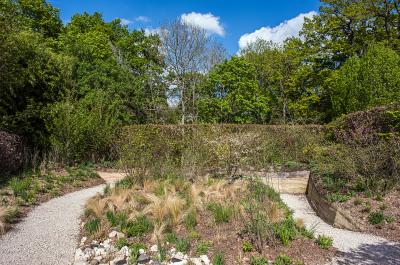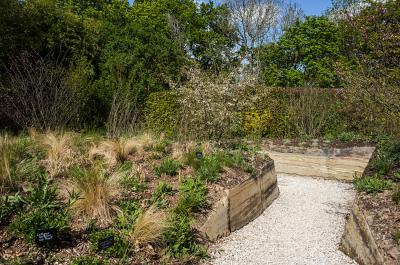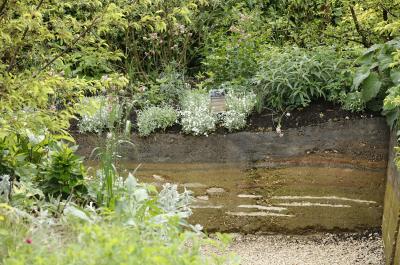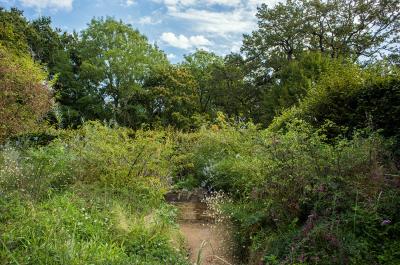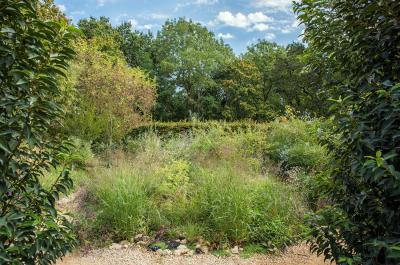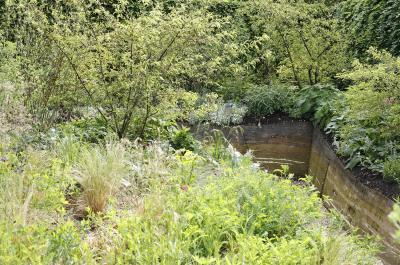Methods are emerging that can breathe new life into dead soil. With patience, it is possible to recreate soil from inert materials, organic matter and improver plants.
There is a narrow fault crossing the Humus sapiens sapiens garden which steadily gets deeper to reveal the buildup of soil layers. Visitors are invited to wander among the three stages involved in reactivating lifeless soil. The entrance hall is made up of clear mineral soil, compacted and trodden on, an allegory of our urban soils – hostile ground where only a few pioneering plants can dare to venture. As we progress through the garden, we can see brown transitional soil where a balance is gradually being struck between the organic and mineral fractions of the soil. This is accompanied by a meadow of improver plants (e.g. green fertilisers, legumes or poaceae) as well as invisible allies – mycorrhizas – which speed up the humification process. Lastly, the contemplative chamber below looks onto a black, living soil: humus. In this deep, rich soil grow woody plants and tall perennials. Sitting in the contemplative room, visitors are faced with successive horizons, evoking the slow reactivation of the soil. Here, we can breathe in the humus and, if we listen carefully, we might even be able to hear earthworms and mycelia hard at work!
DESIGNERS
Yoann SOURICE and Cécile CHARPENTIER, landscape engineers, Swandy WENKER, landscaper
FRANCE
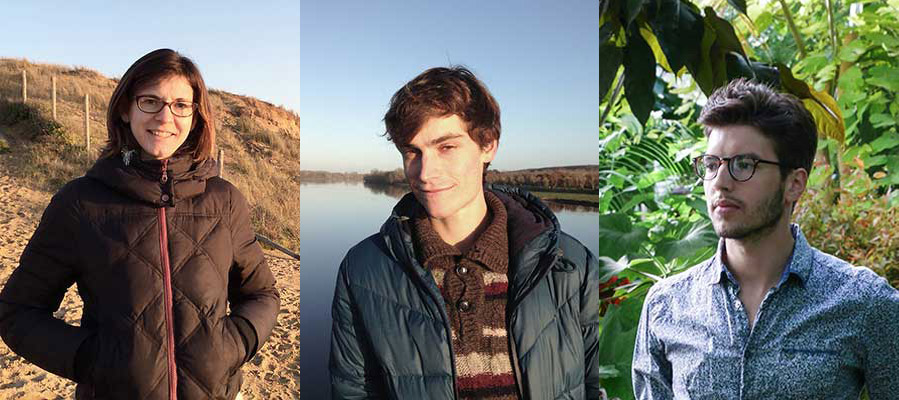
From left to right: Cécile Charpentier, Yoann Sourice and Swandy Wenker
In thrall of plants and garden art, Cécile Charpentier began her studies at Le Breuil School of Horticulture in Paris before enrolling in Blois National School of Nature and Landscape. After completing her final year dissertation on the conversion of the banks of the River Spree in Berlin into a pedestrian walkway, she decided to move there for a spell. Whilst there, she trained in urban design, designing urban parks and public spaces. Upon her return to France, she turned her attentions to studying sweeping landscapes for an environmental design office. Today, she has picked up her first love again: designing gardens for households in Burgundy and the Lyon region, where she gives free rein to her flair for plant combinations. She is also interested in wild, medicinal and edible plants and studies their benefits.
Fascinated by visual art and gardens, Yoann Sourice graduated as a landscape engineer from Blois National School of Nature and Landscape. Over the past few years he has been heading up design projects of public spaces (squares, parks, promenades, etc.) in various landscape firms in Lyon and Paris. At the same time, he assists landscapers in bringing the best out of their projects and communicating on them. Committed to sharing his professional practice and fascination in the visual arts, he teaches drawing at the Marne-la-Vallée French Institute of Urban Planning and is a regular visiting professor at Blois National School of Nature and Landscape. He spends his free time painting and gardening, practising permaculture techniques.
Swandy Wenker first felt drawn to botany in his parents' floral garden on the edge of Fontainebleau Forest. After studying Ecological Management and Development of Urban Landscapes, he made his career debut at the TER firm. These days he is building on the urban and landscape approach by alternating project scales within his own firm -Swandy Wenker Paysagiste- which he set up in 2015. As an artist who showcases plants, he makes his creativity and expertise available to households and professionals who have high expectations and to whom their living environment matters; he works in parks, gardens, terraces and patios - transforming them to make his customers' ideas a reality. Through a focus on forms, colours, textures and fragrances, he designs spaces in step with the seasons which are conducive to contemplation all year round, whether this involve working in keeping with a classical Parisian terrace or an exuberant Mediterranean garden.

